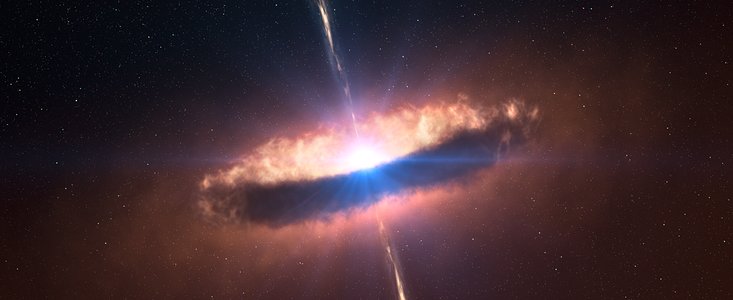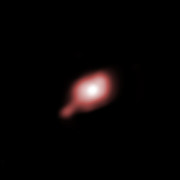Pressmeddelande
Tunga stjärnors gåtfulla start i livet
Alla stjärnor föds på samma sätt
14 juli 2010
Astronomer har lyckats ta den första bilden på en stoftskiva som omger en tung bebis till stjärna. Bilden är ett direkt bevis för att tyngre stjärnor bildas på samma sätt som deras lättviktigare syskon. Upptäckten, som har kunnat göras tack vare flera av ett samarbete mellan flera av ESO:s teleskop, beskrivs i en artikel i veckans nummer av tidskriften Nature.
Stefan Kraus har lett studien.
- Våra observationer visar upp skivan som omger en ung, tung stjärna i vardande, som nu är fullt utvecklad, säger han. Man skulle kunna säga att babyn är på väg att kläckas!
Forskarteamet tittade på ett objekt med det kryptiska namnet IRAS 13481-6124. I dess mitt ligger den unga stjärnan, med en massa på tjugo gånger solens och fem gånger större radie, ännu inlindad i sin födelsekokong. Stjärnan ligger cirka 10 000 ljusår bort i den sydliga stjärnbilden Kentauren.
Utifrån arkivbilder som tagits med NASA:s rymdteleskop Spitzer samt observationer gjorda med det 12-meters submillimeterteleskopet APEX upptäckte astronomerna att här även finns en jetstråle.
- Sådana strålar observerar man vanligtvis runt unga stjärnor med lägre massa. I allmänhet pekar de på att det även finns en skiva, sager Kraus.
Skivor som omger stjärnor är en av beståndsdelarna i processen som leder till att mindre stjärnor, som solen, kan bildas. Däremot vet man inte huruvida sådana skivor även finns med när stjärnor bildas som är tyngre än tio gånger solens massa. Det starka ljusskenet som avges skulle nämligen kunna förhindra att massa faller in från skivan mot stjärnan. Som alternativ har man föreslagit att tunga stjärnor kan bildas när mindre stjärnor smälter samman.
För att kunna upptäcka skivan och undersöka dess egenskaper utnyttjade astronomerna ESO:s Very Large Telescope Interferometer (VLTI). Genom att kombinera ljus från tre hjälpteleskop, med varsin spegel på 1,8 meter, gör VLTI och dess instrument AMBER det möjligt för astronomer att se detaljer som annars skulle kräva ett teleskop med en spegel på 85 meter. Man uppnår en upplösning av cirka 2,3 millibågsekunder, vilket motsvarar att från marken kunna se ett skruvhuvud på den Internationella rymdstationen. Det är mer än tio gånger bättre upplösning än vad som nuvarande rymdteleskop för synligt ljus kan uppnå.
Med denna unika förmåga, kompletterad av observationer som gjorts med ett annat ESO-teleskop, det 3,58-meters NTT (New Technology Telescope) vid La Silla, kunde Kraus med kolleger upptäcka en skiva runt IRAS 13481-6124.
- Det här är första gången som vi har kunnat avbilda de inre delarna hos en skiva runt en ung och tung stjärna, säger Kraus. Våra observationer visar att stjärnbildningen fungerar på samma sätt för alla stjärnor, oavsett massa
Astronomerna fastslår att systemet är cirka 60 000 år gammalt, och att stjärnan har nått sin slutgiltiga massa. På grund av stjärnans intensiva sken – den lyser 30 000 gånger starkare än solen – kommer skivan snart att avdunsta. Den utsvängda skivan sträcker sig ungefär 130 gånger avståndet mellan jorden och solen – 130 astronomiska enheter (ae) – och har en massa som liknar stjärnans, cirka tjugo gånger solens massa. Dessutom visar det sig att skivans inre är fri från stoft.
- Vidare observationer med ALMA (Atacama Large Millimeter/submillimeter Array) som nu byggs i Chile skulle kunna ge mycket information om dessa inre delar, och göra det möjligt för oss att bättre förstå hur tunga stjärnbebisar blev just tunga, fastslår Kraus.
Mer information
Forskningsresultaten presenteras i en artikel i veckans nummer av Nature (“A hot compact dust disk around a massive young stellar object” av S. Kraus m. fl.).
Teamet består av Stefan Kraus (University of Michigan, USA), Karl-Heinz Hofmann, Karl M. Menten, Dieter Schertl, Gerd Weigelt, Friedrich Wyrowski och Anthony Meilland (Max-Planck-Institut für Radioastronomie, Bonn, Tyskland),Karine Perraut (Laboratoire d'Astrophysique de Grenoble, Frankrike), Romain Petrov och Sylvie Robbe-Dubois (Université de Nice Sophia-Antipolis/CNRS/Observatoire de la Côte d’Azur, Frankrika), Peter Schilke (Universität zu Köln, Tyskland) och Leonardo Testi (ESO).
ESO, Europeiska sydobservatoriet, är Europas främsta samarbetsorgan för astronomisk forskning och världens mest produktiva astronomiska observatorium. Det stöds av 14 länder: Belgien, Danmark, Finland, Frankrike, Italien, Nederländerna, Portugal, Schweiz, Spanien, Storbritannien, Sverige, Tjeckien, Tyskland och Österrike. ESO:s ambitiösa verksamhet rör design, konstruktion och drift av avancerade markbaserade forskningsanläggningar som gör det möjligt för astronomer att göra banbrytande vetenskapliga upptäckter. ESO spelar dessutom en ledande roll i att främja och organisera samarbeten inom astronomisk forskning. ESO driver tre unika observationsplatser i Chile: La Silla, Paranal och Chajnantor. Vid Paranal finns Very Large Telescope, världens mest avancerade observatorium för synligt ljus, och VISTA, det största kartläggningsteleskopet. ESO bidrar dessutom till ALMA, ett revolutionerande astronomiskt teleskop och världens hittills största astronomiska projekt. ESO planerar för närvarande bygget av ett 42-meters europeiskt extremt stort teleskop för synligt och infrarött ljus, E-ELT, som kommer att bli ”världens största öga mot himlen”.
Detta är den översatta versionen av ESO:s pressmeddelande 1029, som tagits fram inom ramarna för ESON, ett nätverk av medarbetare i ESO:s medlemsländer som fungerar som lokala kontaktpersoner för media i samband med ESO:s pressmeddelanden och andra händelser. ESON:s kontaktperson i Sverige är Robert Cumming.
Länkar
Kontakter
Stefan Kraus
University of Michigan
USA
Tel: +1 734 615 7374
E-post: stefankr@umich.edu
Richard Hook
ESO
Garching bei München, Germany
Tel: +49 89 3200 6655
E-post: rhook@eso.org
Henri Boffin
ESO, La Silla Paranal and E-ELT Press Officer
Garching bei München, Germany
Tel: +49 89 3200 6222
Mobil: +49 174 515 43 24
E-post: hboffin@eso.org
Johan Warell (Presskontakt för Sverige)
ESO:s nätverk för vetenskaplig kommunikation
Skurup, Sverige
Tel: +46-706-494731
E-post: eson-sweden@eso.org
Om pressmeddelandet
| Pressmeddelande nr: | eso1029sv |
| Namn: | Protoplanetary disc |
| Typ: | Milky Way : Star : Circumstellar Material : Disk : Protoplanetary |
| Facility: | New Technology Telescope, Very Large Telescope, Very Large Telescope Interferometer |
| Instruments: | AMBER, LABOCA, SABOCA |
| Science data: | 2010Natur.466..339K |
Our use of Cookies
We use cookies that are essential for accessing our websites and using our services. We also use cookies to analyse, measure and improve our websites’ performance, to enable content sharing via social media and to display media content hosted on third-party platforms.
ESO Cookies Policy
The European Organisation for Astronomical Research in the Southern Hemisphere (ESO) is the pre-eminent intergovernmental science and technology organisation in astronomy. It carries out an ambitious programme focused on the design, construction and operation of powerful ground-based observing facilities for astronomy.
This Cookies Policy is intended to provide clarity by outlining the cookies used on the ESO public websites, their functions, the options you have for controlling them, and the ways you can contact us for additional details.
What are cookies?
Cookies are small pieces of data stored on your device by websites you visit. They serve various purposes, such as remembering login credentials and preferences and enhance your browsing experience.
Categories of cookies we use
Essential cookies (always active): These cookies are strictly necessary for the proper functioning of our website. Without these cookies, the website cannot operate correctly, and certain services, such as logging in or accessing secure areas, may not be available; because they are essential for the website’s operation, they cannot be disabled.
Functional Cookies: These cookies enhance your browsing experience by enabling additional features and personalization, such as remembering your preferences and settings. While not strictly necessary for the website to function, they improve usability and convenience; these cookies are only placed if you provide your consent.
Analytics cookies: These cookies collect information about how visitors interact with our website, such as which pages are visited most often and how users navigate the site. This data helps us improve website performance, optimize content, and enhance the user experience; these cookies are only placed if you provide your consent. We use the following analytics cookies.
Matomo Cookies:
This website uses Matomo (formerly Piwik), an open source software which enables the statistical analysis of website visits. Matomo uses cookies (text files) which are saved on your computer and which allow us to analyze how you use our website. The website user information generated by the cookies will only be saved on the servers of our IT Department. We use this information to analyze www.eso.org visits and to prepare reports on website activities. These data will not be disclosed to third parties.
On behalf of ESO, Matomo will use this information for the purpose of evaluating your use of the website, compiling reports on website activity and providing other services relating to website activity and internet usage.
Matomo cookies settings:
Additional Third-party cookies on ESO websites: some of our pages display content from external providers, e.g. YouTube.
Such third-party services are outside of ESO control and may, at any time, change their terms of service, use of cookies, etc.
YouTube: Some videos on the ESO website are embedded from ESO’s official YouTube channel. We have enabled YouTube’s privacy-enhanced mode, meaning that no cookies are set unless the user actively clicks on the video to play it. Additionally, in this mode, YouTube does not store any personally identifiable cookie data for embedded video playbacks. For more details, please refer to YouTube’s embedding videos information page.
Cookies can also be classified based on the following elements.
Regarding the domain, there are:
- First-party cookies, set by the website you are currently visiting. They are stored by the same domain that you are browsing and are used to enhance your experience on that site;
- Third-party cookies, set by a domain other than the one you are currently visiting.
As for their duration, cookies can be:
- Browser-session cookies, which are deleted when the user closes the browser;
- Stored cookies, which stay on the user's device for a predetermined period of time.
How to manage cookies
Cookie settings: You can modify your cookie choices for the ESO webpages at any time by clicking on the link Cookie settings at the bottom of any page.
In your browser: If you wish to delete cookies or instruct your browser to delete or block cookies by default, please visit the help pages of your browser:
Please be aware that if you delete or decline cookies, certain functionalities of our website may be not be available and your browsing experience may be affected.
You can set most browsers to prevent any cookies being placed on your device, but you may then have to manually adjust some preferences every time you visit a site/page. And some services and functionalities may not work properly at all (e.g. profile logging-in, shop check out).
Updates to the ESO Cookies Policy
The ESO Cookies Policy may be subject to future updates, which will be made available on this page.
Additional information
For any queries related to cookies, please contact: pdprATesoDOTorg.
As ESO public webpages are managed by our Department of Communication, your questions will be dealt with the support of the said Department.





